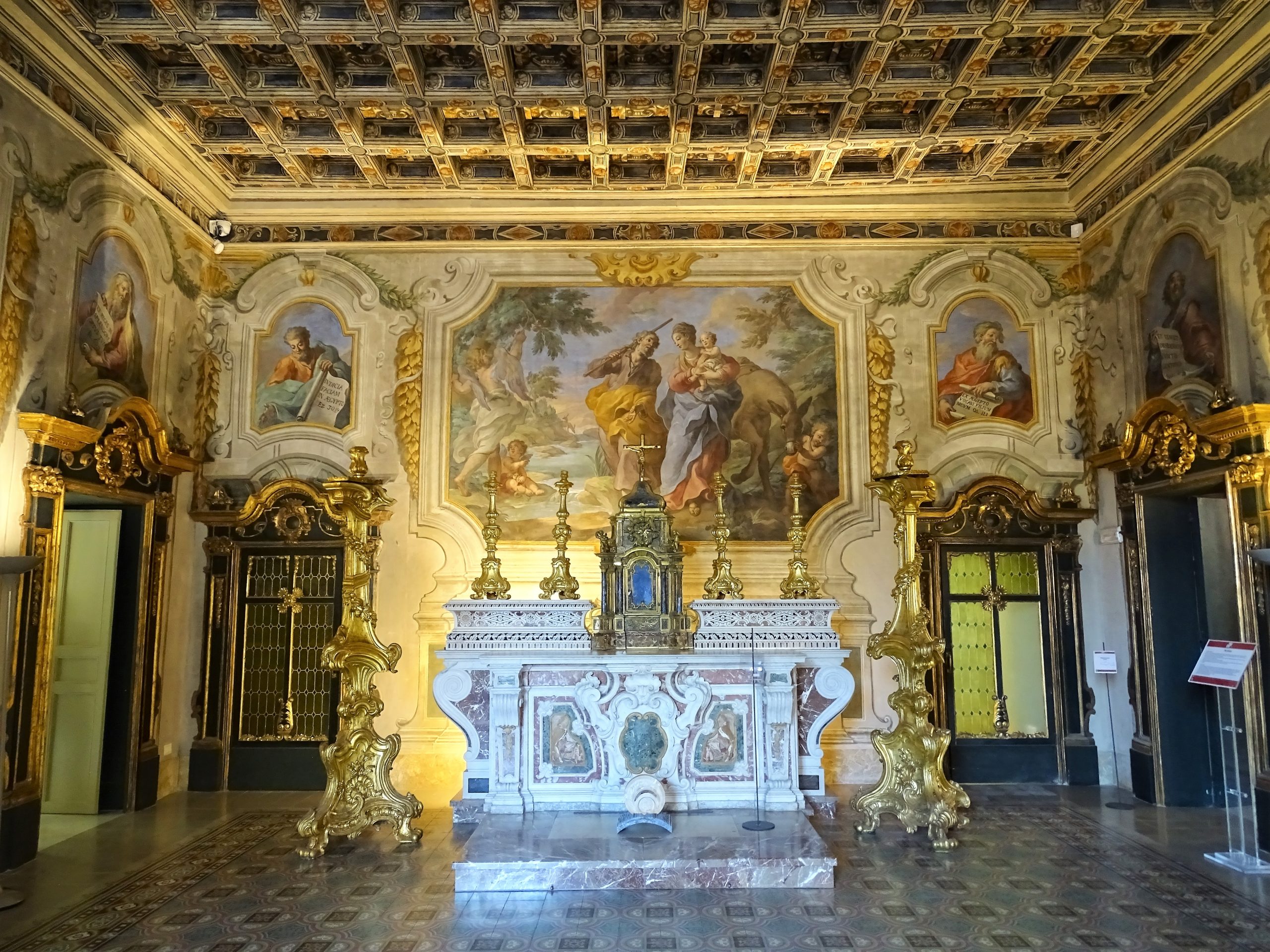
Read English version
Appartengono invece al XIX secolo le decorazioni a tempera che si possono ammirare nei saloni Verde, Giallo e Azzurro. Imperdibile la cappella del pittore fiammingo G. Borremans.
Il palazzo ospita al suo interno il Museo Diocesano.
Il Museo Diocesano di Palermo accoglie tra i suoi splendidi saloni finemente affrescati bellissime pitture, sculture e opere decorative che vanno dal XII al XIX secolo.
Fu realizzato nel 1927 all’ultimo piano del Palazzo Arcivescovile dal cardinale arcivescovo Alessandro Lualdi (1904-1927) in adempimento delle disposizioni emanate dalla Santa Sede.
Costituivano la prima collezione del museo i resti della decorazione marmorea della tribuna gaginiana, già nell’abside della cattedrale, e quelli di diverse cappelle della cattedrale stessa prima che quest’ultima venisse trasformata alla fine del XVIII secolo dall’intervento dell’architetto Ferdinando Fuga. Alla prima collezione vi si aggiunsero poco dopo statue, quadri e altre opere provenienti da chiese distrutte e non più esistenti.
Il Cardinale Arcivescovo Ernesto Ruffini (1945-1967) ampliò ed arricchì il museo aggiungendo altre sale. Il 21 giugno 1952, in occasione della celebrazione del Concilio Plenario Siculo si inaugurava solennemente il Museo Diocesano di Palermo. In ventidue sale e nella loggia venivano esposti centosessanta dipinti eseguiti in otto secoli di storia palermitana, stampe, disegni, sculture e tutto quello che nei secoli hanno realizzato artisti e ingegni italiani e d’oltralpe per le chiese e gli oratori di Palermo e Sicilia. Nel 1972, per volontà del cardinale arcivescovo Salvatore Pappalardo, i saloni di rappresentanza su via Matteo Bonello sono stati destinati a sede del Museo Diocesano. Tra le opere imperdibili la Santa Cecilia del Barbalonga, la Palermo liberata dalla peste di Simone De Wobreck …
ENGLISH
In the mid-fifteenth century the Archiepiscopal Palace was created by the will of the archbishop Simone Beccadelli from Bologna (1445-1465), in place of the Vecchio Arcivescovado (Old Archbishopric), which was on the north of the Cathedral. Even today you can admire the elegant three-mullioned flamboyant gothic window and the Gothic-Catalan portal of the 15th century Palace where the founder’s coat of arms is sculpted. The first enlargement of the building is due to the Genoese archbishop Giannettino Doria (1608-1640). It was in this century that on the Cathedral the balconies which replaced the ancient loggia and the first large courtyard were built. Still visible today are the remarkable interventions that took place in the following centuries, such as the frescoes made in the first half of the eighteenth century by the Flemish Guglielmo Borremans and the paintings by the Roman Gaspare Fumagalli and his followers. The tempera decorations that can be admired in the ‘Verde, Giallo and Azzurro Exhibitions’ belong instead to the 19th century. Not to be missed is the chapel by the Flemish painter G. Borremans. The building houses the Diocesan Museum inside. Among its splendid finely frescoed halls the Diocesan Museum of Palermo hosts beautiful paintings, sculptures and decorative works ranging from the twelfth century to the nineteenth century. The Museum was created on the second (top) floor of the Archbishop’s Palace by the Cardinal Archbishop Alessandro Lualdi (1904-1927) in fulfillment of the provisions issued by the Holy See in 1927 .
The first collection of the museum consisted of the marble decoration remains from the Gagini tribune, previously in the apse of the Cathedral, and of other remains from several chapels of the same Cathedral before it was transformed by the intervention of architect Ferdinando Fuga at the end of the eighteenth century . Some statues, paintings and other works were added to the first collection shortly after, taken from destroyed churches. The Cardinal Archbishop Ernesto Ruffini (1945-1967) expanded and enriched the Museum by adding other rooms. On 21 June 1952, on the occasion of the Sicilian Plenary Council, the Diocesan Museum of Palermo was solemnly inaugurated. In twenty-two rooms and in the loggia the museum exhibited one hundred and sixty paintings executed during the eight centuries of Palermo history, prints, drawings, sculptures and all that had been created by Italian artists and foreign and genius artists for the churches and oratories of Palermo and Sicily for centuries. In 1972, by the will of Cardinal Archbishop Salvatore Pappalardo, the representative rooms on Via Matteo Bonello were destined to house the Diocesan Museum. Among the unmissable works are: “Santa Cecilia” by Barbalonga, “Palermo Freed from The Plague ” by Simone de Wobreck…
